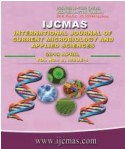


 National Academy of Agricultural Sciences (NAAS)
National Academy of Agricultural Sciences (NAAS)

|
PRINT ISSN : 2319-7692
Online ISSN : 2319-7706 Issues : 12 per year Publisher : Excellent Publishers Email : editorijcmas@gmail.com / submit@ijcmas.com Editor-in-chief: Dr.M.Prakash Index Copernicus ICV 2018: 95.39 NAAS RATING 2020: 5.38 |
This study was completed to know the prevalence of Methicillin-Susceptible (MSSA) and Methicillin-Resistant S. aureus (MRSA) in swab samples from retail meat shops (RM) and customers (CU) in five districts of Punjab, India. An aggregate of 182 swabs samples was aseptically collected from RM shops and customers. The collected samples were processed for an isolation of S. aureus isolates. The phenotypic resistance of S. aureus isolates was most noteworthy to Penicillin (PEN, 97.83%) trailed by Ciprofloxacin (CPH, 56.52%), Tetracycline (TET, 36.96%), Trimethoprim-Sulfamethoxazole (TSH, 34.78%) and Erythromycin (ERY, 17.39%). However, low resistance was observed to Clindamycin, Chloramphenicol, Oxacillin, Ceftriaxone, and that fluctuated from 2%-7%. None of the isolates was phenotypically resistant to vancomycin (MIC 0.5-2 µg/ml). A large portion of S. aureus isolates (58.69%, 95% CI 43.63-61.93) were Multi-drug resistant (MDR) and carried resistant genes to penicillin (blaZ), oxacillin (mecA), gentamicin (aacA-aphD), erythromycin (ermB, ermC) and tetracycline (tetK, tetM). Two S. aureus isolates were borderline oxacillin resistant (BORSA) with MIC 4 µg/ml and one isolate was MRSA (Oxacillin MIC 16 µg/ml) with a genotypic profile, mecA+blaZ+aacA-aphD+tetK+ermC+. Among the erythromycin-resistant or intermediate resistant isolates, none expressed inducible macrolide lincosamide and streptogramin (MLSB) phenotype (ERY+/CLI-, D+) except for one MSSA isolates from CU hand swab sample that demonstrated a constitutive MLSB phenotype (Erm+/Cli+, D-).
 |
 |
 |
 |
 |